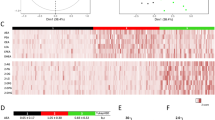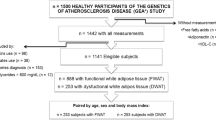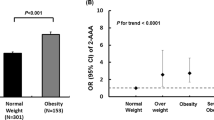Abstract
Objective:
The link between excess intra-abdominal adiposity (IAA) and metabolic complications leading to type 2 diabetes and cardiovascular disease is well recognized. Blockade of endocannabinoid action at cannabinoid CB1 receptors was shown to reduce these complications. Here, we investigated the relationship between IAA, circulating endocannabinoid levels and markers of cardiometabolic risk in male obese subjects.
Design, subjects and measurements:
Fasting plasma levels of the endocannabinoids, anandamide (AEA) and 2-arachidonoylglycerol (2-AG), were measured by liquid chromatography-mass spectrometry in a study sample of 62 untreated asymptomatic men with body mass index (BMI) from 18.7 to 35.2 kg/m2.
Results:
Plasma 2-AG, but not AEA, levels correlated positively with BMI, waist girth, IAA measured by computed tomography, and fasting plasma triglyceride and insulin levels, and negatively with high-density lipoprotein cholesterol and adiponectin levels. Obese men with similar BMI values (⩾30 kg/m2) but who markedly differed in their amount of IAA (< vs⩾130 cm2, n=17) exhibited higher 2-AG levels in the presence of high IAA. No difference in 2-AG concentrations was observed between obese men with low levels of IAA vs nonobese controls.
Conclusions:
These results provide evidence for a relationship in men between a key endocannabinoid, 2-AG, and cardiometabolic risk factors, including IAA.
This is a preview of subscription content, access via your institution
Access options
Subscribe to this journal
Receive 12 print issues and online access
$259.00 per year
only $21.58 per issue
Buy this article
- Purchase on Springer Link
- Instant access to full article PDF
Prices may be subject to local taxes which are calculated during checkout



Similar content being viewed by others
References
Bray GA, Bouchard C, James WPT (eds.) 1998 Handbook of Obesity. Marcel Dekker: New York.
Di Marzo V, Matias I . Endocannabinoid control of food intake and energy balance. Nat Neurosci 2005; 8: 585–589.
Van Gaal LF, Rissanen AM, Scheen AJ, Ziegler O, Rossner S . Effects of the cannabinoid-1 receptor blocker rimonabant on weight reduction and cardiovascular risk factors in overweight patients: 1-year experience from the RIO-Europe study. Lancet 2005; 365: 1389–1397.
Fu J, Oveisi F, Gaetani S, Lin E, Piomelli D . Oleoylethanolamide, an endogenous PPAR-alpha agonist, lowers body weight and hyperlipidemia in obese rats. Neuropharmacology 2005; 48: 1147–1153.
Després JP, Golay A, Sjostrom L . Effects of rimonabant on metabolic risk factors in overweight patients with dyslipidemia. N Engl J Med 2005; 353: 2121–2134.
Sipe JC, Waalen J, Gerber A, Beutler E . Overweight and obesity associated with a missense polymorphism in fatty acid amide hydrolase (FAAH). Int J Obes Relat Metab Disord (Lond) 2005; 29: 755–759.
Lohman T, Roche A, Martorel R . The Airlie (VA) consensus conference standardization of anthropometric measurements. In: Standardization of Anthopometric Measurements. Champaign: IL, 1988; 39–80.
van der Kooy K, Seidell JC . Techniques for the measurement of visceral fat: a practical guide. Int J Obes Relat Metab Disord 1993; 17: 187–196.
Behnke AR, Wilmore JH . Evaluation and regulation of body build and composition. In: Cliffs E, (ed). Englewood Cliffs, NJ: Prentice-Hall, 1974. pp 20–37.
Siri WE . The gross composition of the body. Adv Biol Med Phys 1956; 4: 239–280.
Ferland M, Després JP, Tremblay A, Pinault S, Nadeau A, Moorjani S et al. Assessment of adipose tissue distribution by computed axial tomography in obese women: association with body density and anthropometric measurements. Br J Nutr 1989; 61: 139–148.
Havel RJ, Eder H, Bragdon HF . The distribution and chemical composition of ultracentrifugally separated lipoproteins in human serum. J Clin Invest 1955; 34: 1345–1353.
Burstein M, Samaille J . Sur un dosage rapide du cholestérol lié aux beta-lipoprotéines du sérum. Clin Chim Acta 1960; 5: 609–610.
Richterich R, Dauwalder H . Zur bestimmung der plasmaglukosekonzentration mit der hexokinase- glucose-6-phosphat-dehydrogenase-methode. Schweiz Med Wochenschr 1971; 101: 615–618.
Desbuquois B, Aurbach GD . Use of polyethylene glycol to separate free and antibody- bound peptide hormones in radioimmunoassays. J Clin Endocrinol Metab 1971; 37: 732–738.
De Marchi N, De Petrocellis L, Orlando P, Daniele F, Fezza F, Di Marzo V . Endocannabinoid signalling in the blood of patients with schizophrenia. Lipids Health Dis 2003; 2: 5.
Després JP, Lamarche B . Effects of diet and physical activity on adiposity and body fat distribution:implications for the prevention of cardiovascular disease. Nutr Res Rev 1993; 6: 137–159.
Engeli S, Bohnke J, Feldpausch M, Gorzelniak K, Janke J, Batkai S et al. Activation of the peripheral endocannabinoid system in human obesity. Diabetes 2005; 54: 2838–2843.
Matias I, Gonthier MP, Orlando P, Martiadis V, De Petrocellis L, Cervino C et al. Adipo-insular hyperactivity of the endocannabinoid system in obesity and hyperglycaemia. J Clin Endocrinol Metab 2006; 91: 3171–3180.
Després JP, Lemieux I, Almeras N . Contribution of CB1 blockade to the management of high-risk abdominal obesity. Int J Obes Relat metab Disord (Lond) 2006; 30 (Suppl 1): S44–S52.
Sugiura T, Kobayashi Y, Oka S, Waku K . Biosynthesis and degradation of anandamide and 2-arachidonoylglycerol and their possible physiological significance. Prostaglandins Leukot Essent Fatty Acids 2002; 66: 173–192.
Di Marzo V, De Petrocellis L, Fezza F, Ligresti A, Bisogno T . Anandamide receptors. Prostaglandins Leukot Essent Fatty Acids 2002; 66: 377–391.
Valenti M, Viganò D, Cascio MG, Rubino T, Steardo L, Parolaro D et al. Differential diurnal variations of anandamide and 2-arachidonoyl-glycerol levels in rat brain. Cell Mol Life Sci 2004; 61: 945–950.
Osei-Hyiaman D, DePetrillo M, Pacher P, Liu J, Radaeva S, Batkai S et al. Endocannabinoid activation at hepatic CB1 receptors stimulates fatty acid synthesis and contributes to diet-induced obesity. J Clin Invest 2005; 115: 1298–1305.
Bouaboula M, Hilairet S, Marchand J, Fajas L, Le Fur G, Casellas P . Anandamide induced PPARgamma transcriptional activation and 3T3-L1 preadipocyte differentiation. Eur J Pharmacol 2005; 517: 174–181.
Koga D, Santa T, Fukushima T, Homma H, Imai K . Liquid chromatographic-atmospheric pressure chemical ionization mass spectrometric determination of anandamide and its analogs in rat brain and peripheral tissues. J Chromatogr B Biomed Sci Appl 1997; 690: 7–13.
Maccarrone M, Attina M, Bari M, Cartoni A, Ledent C, Finazzi-Agro A . Anandamide degradation and N-acylethanolamines level in wild-type and CB1 cannabinoid receptor knockout mice of different ages. J Neurochem 2001; 78: 339–348.
Lo Verme J, Fu J, Astarita G, La Rana G, Russo R, Calignano A et al. The nuclear receptor peroxisome proliferator-activated receptor-alpha mediates the anti-inflammatory actions of palmitoylethanolamide. Mol Pharmacol 2005; 67: 15–19.
Blüher M, Engeli S, Kloting N, Berndt J, Fasshauer M, Batkai S et al. Dysregulation of the peripheral and adipose tissue endocannabinoid system in human abdominal obesity. Diabetes 2006; 55: 3053–3060.
Richardson D, Ortori CA, Chapman V, Kendall DA, Barrett DA . Quantitative profiling of endocannabinoids and related compounds in rat brain using liquid chromatography–tandem electrospray ionization mass spectrometry. Anal Biochem in press (Epub ahead of print).
Acknowledgements
This work was partly supported by research grants from Sanofi-Aventis (to VDM) and CIHR (to JPD).
Author information
Authors and Affiliations
Corresponding authors
Rights and permissions
About this article
Cite this article
Côté, M., Matias, I., Lemieux, I. et al. Circulating endocannabinoid levels, abdominal adiposity and related cardiometabolic risk factors in obese men. Int J Obes 31, 692–699 (2007). https://doi.org/10.1038/sj.ijo.0803539
Received:
Revised:
Accepted:
Published:
Issue Date:
DOI: https://doi.org/10.1038/sj.ijo.0803539
Keywords
This article is cited by
-
Dietary food patterns as determinants of the gut microbiome–endocannabinoidome axis in humans
Scientific Reports (2023)
-
Circulating endocannabinoid levels in pregnant women with gestational diabetes mellitus: a case–control study
BMC Endocrine Disorders (2022)
-
The endocannabinoid system in the adipose organ
Reviews in Endocrine and Metabolic Disorders (2022)
-
The effects of cannabis and cannabinoids on the endocrine system
Reviews in Endocrine and Metabolic Disorders (2022)
-
Cannabinoid receptor 1 expression is higher in muscle of old vs. young males, and increases upon resistance exercise in older adults
Scientific Reports (2021)



